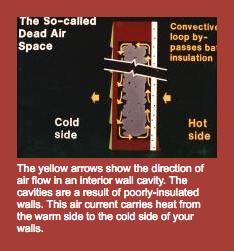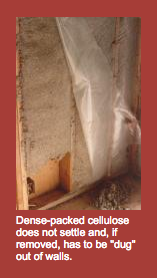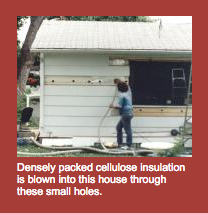Why am I so Cold?

Good question! Let's start to answer that by looking at walls. Walls are the largest exterior surface areas of most homes and are also exposed to wind load and large amounts of air infiltration. Uninsulated or poorlyinsulated walls are ideal for convection heat transfer because of internal wall cavities. These cavities, which are more prevalent than most people think, are caused by little or no insulation or poorly-installed insulation. Exterior walls with an air cavity between their cold and warm side allow air currents inside the walls to carry warmth from one side of the wall to the other.
If you can feel drafts around your socket and switch plates, then there is either no insulation, or your walls are so poorly insulated that the heat and cold air blow right around the insulation. Cellulose insulation can save up to 75% of conductive, infiltrative, convective, and radiated heat loss through wall cavities. Wall cavities blown full will loose less heat than a wall insulated with the usual fiber-glass batts.
Dense-packed cellulose does not settle and, if removed, has to be "dug" out of walls.
Safer Walls

Besides adding to convective heat loss, air gaps in the walls can also act like chimneys during a fire. Walls blown full of fire-retardant cellulose improve the fire rating byarresting air flows in the cavity with fire-rated material. (All the cellulose we use is treated with the non-toxic fire-retardants Borax and Boric acid.)
Getting Retrofitted
If your home was built before 1980, then there is a good chance that there is no insulation in your walls. Colorado's first energy code was past in November 1979 and before that wall insulation was not required and never inspected. During the housing boom of the mid 1970s, there was an insulation shortage but builders did not stop production. No matter when your home was built though, the insulation was probably pushed in from the interior leaving large, vertical air gaps in your walls. In most framed homes, including brick veneer, we can greatly improve the insulation quality of your walls by blowing in insulation from the exterior. The blown insulation will fill all the voids and flaws in the wall cavities, including holes and pathways around plumbing and wires.
About Saving Heat Co. will improve the performance of your existing wall insulation with the Dense Pack Method, a system we helped develop that assures a complete fill which won't settle. When blowing in the insulation, we pack it in your walls at about twice its own density which ensures a tight fit that won't loosen over time. It's similar to stuffing a sleeping bag into a stuff sack; the bag, like the insulation, wants to spring up but when stuffed, the fibers remain locked in place.
Winter Problems:
Poorly insulated walls are like a down parka with a broken zipper; the heat can get around the down and greatly reduce its overall effectiveness. This airflow is what freezes pipes and chills your home. This wind chill effect can pull more heat out than still air. To test, feel for drafts on cold nights around outlets and switch plates in exterior walls.

Summer Problems:
Walls exposed to sunlight can get extremely hot. In an uninsulated or poorly insulated wall, heat can easily be transferred from the hot exterior wall to the cooler interior wall by convection, conduction, and radiation. Blowing the walls full can also slow down the heat gain by about 75%, which will increase your summer comfort and lower cooling costs.
Contact us today!
Testimonials
"For blown cellulose insulation, I've found [ASHCo] to be the best. I appreciate their flexibility to work within my schedule, your expertise and the thorough job."

